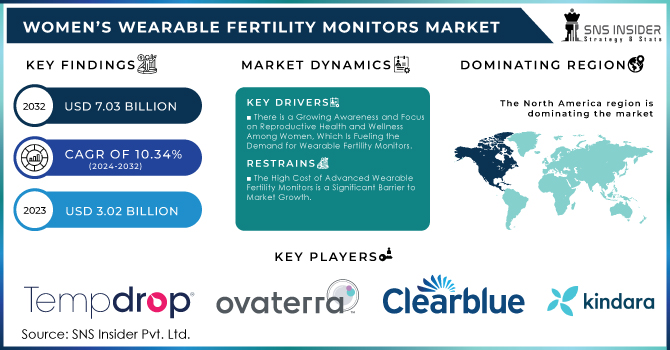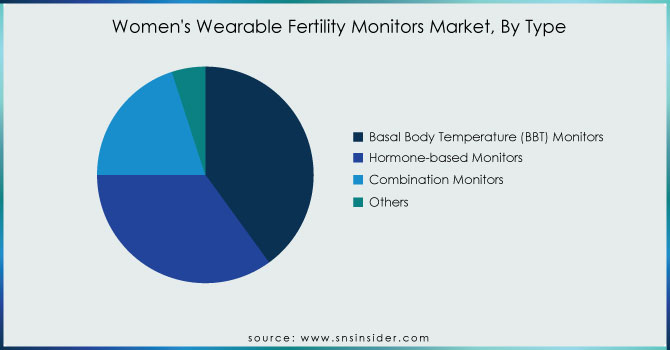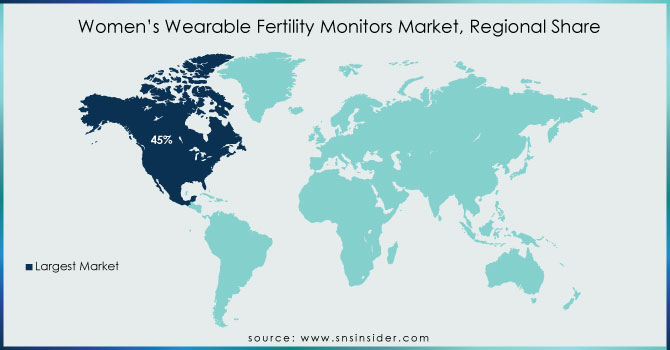Women’s Wearable Fertility Monitors Market Report Scope & Overview:

Get more information on Women’s Wearable Fertility Monitors Market - Request Free Sample Report
The Women’s Wearable Fertility Monitors Market Size was valued at USD 3.02 Billion in 2023, and is expected to reach USD 7.03 Billion by 2032, and grow at a CAGR of 10.34% over the forecast period 2024-2032.
The rise of awareness and attention on women's reproductive health & wellness continues to surge, thus adding a glow to the demand for wearable fertility monitors as well. As women take more control of their health, personalized family planning, and fertility management have found broad appeal. The issue is more common than one might think: the CDC estimates that up to 12% of women aged 15-44 in the United States have trouble getting pregnant or carrying a pregnancy to term - which means there lays an abundance of solutions that can be both accessible and reliable. Increased demand for accurate and easy-to-use fertility tracking devices is fueled by efforts to improve education, and stories both in the media and online content about reproductive health. Typically, this can influence them, however public awareness and support by governments that hold up women who are suffering has shown incredible change. For instance, activities such as National Women's Health Week launched by the U.S. Department of Health and Human Services which emphasizes reproductive health; encourage women to be responsible for their health by becoming informed about how they can improve or maintain it in great condition and avoid accidents that could lead to unintentional bankrupting decomposition.
Alongside governmental efforts, numerous NGOs and advocacy groups are hard at work fighting for reproductive health education. These organizations offer invaluable resources about fertility, menstrual health, and family planning that give women a resource to use when making important decisions regarding their reproductive system. Media plays a huge part as well in spreading the word and making conversations about fertility tracking devices more normalized, which then makes it easier for women to find out where they can use this kind of information. Advanced wearable fertility monitors have been game-changers and help women take control of their reproductive health. These devices provide real-time data about fertility cycles, using advanced sensors and algorithms to track important biomarkers: basal body temperature (BBT), hormone residues in saliva or cervical mucus changes throughout the menstrual cycle, as well heart rate variability. Combining wearable devices with mobile applications makes it even more comfortable for women to track down their fertility data and personalized recommendations.
So, it should come as no surprise that wearable fertility monitors are being adopted with increasing frequency. Educational initiatives and increased awareness, paired with technological advancements in the past decade have fostered a supportive culture for women to reclaim their reproductive health. There is increasing evidence to suggest this trend will continue, as efforts are made on an ongoing basis for more public education and increasingly user-friendly fertility tracking solutions hit the market. At its core, this increased attention to reproductive health and wellness suggests that wearable fertility monitors helping women plan their family planning goals better or be more proactive in monitoring reproductive well-being are an important tool for both purposes.
MARKET DYNAMICS:
KEY DRIVERS:
-
The Integration of Wearable Fertility Monitors with Telemedicine Services and Digital Health Platforms Is Boosting the Growth of The Women’s Wearable Fertility Monitors Market.
-
There is a Growing Awareness and Focus on Reproductive Health and Wellness Among Women, Which Is Fueling the Demand for Wearable Fertility Monitors.
RESTRAINTS:
-
The High Cost of Advanced Wearable Fertility Monitors is a Significant Barrier to Market Growth.
-
Wearable Fertility Monitors Collect Sensitive Personal Health Data Which Raises Concerns about Data Privacy and Security and can Hinder Market Growth.
OPPORTUNITY:
-
There is Significant Growth Potential in Emerging Markets Such as Asia-Pacific, Latin America, and the Middle East and Africa Offer Significant Growth Opportunities.
-
The Continuous Development of Advanced Technologies in Wearable Devices Is a Key Driver for The Women’s Wearable Fertility Monitors Market.
KEY MARKET SEGMENTATION:
By Type
BBT monitor segment accounted for the largest share i.e. 40% of women's wearable fertility monitors market in 2023. Their large market share is explained by their accuracy and reliability in monitoring fertility cycles with a BBT monitor. The National Institutes of Health (NIH) report states that basal body temperature is a reliable tool to know when ovulation will take place since there's an increase in female corporal temperature during this period. For this reason, many women who are trying to understand and regulate their cycles prefer BBT monitors. Government and health organizations are only adding fuel to the fire by recommending BBT monitors. For example, the CDC states that using fertility awareness methods (FAMs) - including monitoring BBT - to track ovulation is a natural and non-invasive approach. More women are seeing the value of BBT monitoring and incorporating these devices into their reproductive health routines, helped by educational campaigns and resources from public health institutions that increase awareness.
BBT monitors are also popular because of their ease of use and accuracy. Each modern BBT monitor now features more advanced and sensitive sensors, along with digital interfaces providing exact temperature readings versus paper records. It is often accompanied by its integration with mobile applications, which show reading results via a graph and can include data on menstrual cycles - women may receive personalized tips + notifications. In addition, the low cost and user-friendliness of BBT monitors also account for their preponderance.

Get Customized Report as per your Business Requirement - Request For Customized Report
By Technology
The top segment of women's wearable fertility monitors by technology in 2023 encompasses devices with advanced sensors and accounts for the majority of sales which is 48%. This dominance is due to the importance of high-precision sensors in both measuring and predicting fertility cycles. The accuracy of fertility tracking depends on high-quality physiological data, according to NIH (National Institutes of Health). The second part here is played by the sensors - they measure the basal body temperature (BBT), hormone level, and HRV. These metrics are needed for determining ovulation and fertility periods. Therefore, as the NIH points it is also vital to have a proper ovulation prediction that can improve family planning and fertility management making reliable sensor technology a crucial part of wearable fertility monitors that meet these clinical threshold levels.
Sensors and sensor-based devices get support from government and health organizations since their effectiveness is well-proven. The Centers for Disease Control and Prevention (CDC), on the other hand, recommends using fertility awareness methods that are based on quantifiably accurate physiological measurements. The use of sensor-based devices works perfectly with these algorithmic recommendations, delivering reliable information for each individual to decide on his or her better course when it comes to reproductive health. Additionally, the increased sensor accuracy and sensitivity are also a major reason for the higher prevalence of sensor-based fertility monitors in the global market. Small variations in temperature, hormone levels, and other physiological markers can be sensed with very high accuracy by today's sensors. It is necessary for accurate fertility tracking, and thus female users as well as healthcare providers prefer devices with high-quality sensors.
REGIONAL ANALYSIS:
The women's wearable fertility monitors market in North America hold a significant 45% share in 2023. The dominance is expected to be supported by several factors such as high consumer awareness, abundant healthcare infrastructure, and greater investment in health technology. A study conducted by the CDC revealed that around 12% of women aged between 15 and 44 in the country have difficulty getting pregnant, further reinforcing how there is a market for reliable fertility monitoring technologies. With a strong healthcare system in the region coupled with proactive public health programs and awareness initiatives, fertility monitors are being increasingly used. Moreover, the high disposable income levels of North America make it possible for more women to invest in these sophisticated health devices. Having this awareness, infrastructure, and economic capacity cement North America as the leader in that market.

KEY PLAYERS:
The key market players include Tempdrop, Ovaterra, Ava Science, kegg, Clearblue, Food Freedom Fertility, Kindara, OvuSense, Proov, Natural Cycles & Other players.
RECENT DEVELOPMENTS
In October 2023, A team of scientists at the California Institute of Technology made a wearable sensor capable of accurately detecting sweat for estradiol in October 2023. A wearable estrogen sensor might also help women on hormone replacement therapy (HRT).
| Report Attributes | Details |
|
Market Size in 2023 |
US$ 3.02 Billion |
|
Market Size by 2032 |
US$ 7.03 Billion |
|
CAGR |
CAGR of 10.34% From 2024 to 2032 |
|
Base Year |
2023 |
|
Forecast Period |
2024-2032 |
|
Historical Data |
2020-2022 |
|
Report Scope & Coverage |
Market Size, Segments Analysis, Competitive Landscape, Regional Analysis, DROC & SWOT Analysis, Forecast Outlook |
|
Key Segments |
•By Type (Basal Body Temperature (BBT) Monitors, Hormone-based Monitors, Combination Monitors & Others) |
|
Regional Analysis/Coverage |
North America (US, Canada, Mexico), Europe (Eastern Europe [Poland, Romania, Hungary, Turkey, Rest of Eastern Europe] Western Europe] Germany, France, UK, Italy, Spain, Netherlands, Switzerland, Austria, Rest of Western Europe]), Asia Pacific (China, India, Japan, South Korea, Vietnam, Singapore, Australia, Rest of Asia Pacific), Middle East & Africa (Middle East [UAE, Egypt, Saudi Arabia, Qatar, Rest of Middle East], Africa [Nigeria, South Africa, Rest of Africa], Latin America (Brazil, Argentina, Colombia, Rest of Latin America) |
|
Company Profiles |
Tempdrop, Ovaterra, Ava Science, kegg, Clearblue, Food Freedom Fertility, Kindara, OvuSense, Proov, Natural Cycles & Other players |
|
Key Drivers |
•The Integration of Wearable Fertility Monitors with Telemedicine Services and Digital Health Platforms Is Boosting the Growth of The Women’s Wearable Fertility Monitors Market. |
|
RESTRAINTS |
•The High Cost of Advanced Wearable Fertility Monitors is a Significant Barrier to Market Growth. |

